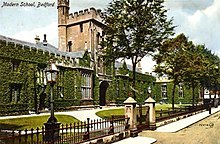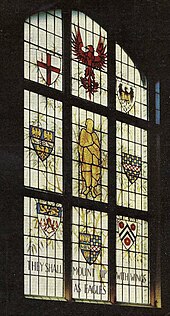|
Bedford Modern School
Bedford Modern School (often called BMS or simply Modern) is a Headmasters' and Headmistresses' Conference independent school in Bedford, England.[1] The school has its origins in The Harpur Trust, born from the endowments left by Sir William Harpur in the sixteenth century.[2] BMS comprises a junior school (ages 6–11) and a senior school (ages 11–18).[1] The school has had four names.[2] In 1873 the school became Bedford Modern School to reflect its modern curriculum, providing an education for the professions.[2] BMS provided education not only for the locality but also for colonial and military personnel abroad, seeking good education for their young families.[2] HistoryBedford Modern School has its origins in The Harpur Trust, born from the endowments left by Sir William Harpur in the sixteenth century.[3] Since the separation of Bedford School and BMS in 1764, the School has had four names: the Writing School, the English School, the Commercial School and finally Bedford Modern School, the last change being made in 1873 to reflect the School's modern curriculum, providing an education for the professions.[2]   BMS provided education not only for the locality but also for colonial and military personnel seeking good education for their young families.[2] In 1834 BMS moved from its original premises in St Paul's Square to buildings designed by Edward Blore in Harpur Square, Bedford.[2] The ‘Long Swim’ was established under Robert Poole (headmaster of BMS from 1877 to 1900), a ‘free-for-all’ swimming race in the River Great Ouse from Bedford town bridge to the ‘Suspension Bridge’. The gruelling event was stopped in 1957 due to river pollution.[2] Up to 2010 an annual compulsory steeplechase was still taking place at the school for each year group.[4] During World War II, the inventors Cecil Vandepeer Clarke and Stuart Macrae took a prototype of their limpet mine to Bedford Modern School swimming baths, which were closed for such occasions. Clarke was an excellent swimmer and was able to propel himself through the water with a prototype bomb attached to a keeper plate on webbing around his waist.[5] Dame Alice Owen's School was evacuated to BMS for the entire duration of World War II.[2][6] The school’s Prichard Museum, a collection of artefacts sent back to the school mainly from old boys around the world, became Bedford Museum.[2] George Witt was a major benefactor to the school's museum.[7] The successful growth of the school meant that the buildings became increasingly cramped and in 1974 the school moved to new premises in Bedford.[2] The Foundation Stone for the new building was laid by Margaret Thatcher.[2] On 11 May 1976, Queen Elizabeth II unveiled a commemorative panel at the new school building during her visit with Prince Philip, Duke of Edinburgh.[2] BMS became a coeducational day school in 2003. In 2014, BMS celebrated the 250th anniversary of its separation from Bedford School.[4] David Scott Daniell wrote about his schooldays at BMS in his first novel, Young English.[8][9] School housesFollowing a tradition of over a hundred years the Senior School Houses of BMS were: North, South, East, West, County and United Boarders.[2] United Boarders comprised the combined boarding houses: Culver, Shakespeare, and School House.[2] The day boy houses often, though not always, reflected the parts of the town or county from which the boys hailed and were mentioned in the chorus of the school song.[2]
A decision was made in October 1997 for the house system to play a more central role in the school and to reinvigorate internal competition whilst upholding its traditions.[4] Six heads of house were appointed from the staff under the direction of a senior head of house, with the brief to establish a modern house system to be integrated into a new school structure and working week, beginning in September 1998.[4] A competition was launched to establish the new house names. The houses were named in honour of six Old Bedford Modernians who had gained national or international recognition in their field.[4] Each house has its own tie which consists of stripes of the three school colours and their own house colour.[4] Inter-house sports cover all major and minor sports run by the school, at both junior and senior level, and range from rugby and hockey (major sports) to shooting and fencing (minor sports).[4] There are also non-sporting events such as quizzes and Music and Drama competitions.[4] Students take leadership roles as house captain or house deputies.[4] Monitors Monitors are selected, following a written application process, from students in the upper sixth.[4] Each team of monitors works with a specific year group, and are led by two senior monitors, appointed by the head master.[4] Senior monitors, along with the heads of school, are entitled to wear a red trim on their blazer.[4] CoeducationUntil 2003, BMS was a day and boarding school for boys.[4] Following 12 years of discussions, Bedford Modern School closed its boarding houses and became coeducational in September 2003.[4] In 2013, BMS celebrated 10 years of coeducation, with a play written by Mark Burgess commissioned to celebrate the event. Extracurricular activitiesSport   BMS competes against Bedford School, Berkhamsted School, Bishop's Stortford College, Eton College, Hampton School, Harrow School, Kimbolton School, Haileybury, Merchant Taylors, Oakham School, Oundle School, St Albans School, Stowe School and Stamford School in rugby union or rowing. Other sports include cricket, hockey, athletics, fencing, Rugby fives, football, swimming, table tennis, tennis and water polo. The school has extensive sports facilities including: Boat House (rowing), Rugby, Football, Hockey, Rounders and Cricket pitches, Tennis, Badminton, Netball and Basketball Courts, Swimming Pool, Climbing wall, Fencing Gym, Fives Court building, Strength and Conditioning Gym, Athletics track (Summer only) with long jump pits and high jump. The shooting range was closed and demolished to make space for the new science faculty in 2014.[10] Bedford Modern has had former students going on to compete at national and international levels including two former captains of the England national rugby union team and a former captain of the England cricket team.
The school was selected as an official training site for the 2012 Summer Olympics and Paralympics.[19] Performance artsEach year, the school puts on two productions, normally musicals, with full orchestra and set, in its 300-seat auditorium. It also hosts its own Shakespeare Festival, in which local schools are invited to take part. The sixth form has its own theatre company, Theatre in Transit, which puts on a piece of theatre each year at professional venues.[20] In September 2014, the Chamber Choir performed The Armed Man at the Royal Albert Hall as part of Sing UK's 'A Mass for Peace'.[21] Combined Cadet Force BMS Combined Cadet Force was established in 1900 and comprises three sections: the Royal Navy, the Army and the Royal Air Force.[22] The Royal Marines section was closed in 2018.[22] Eagle magazine The school has several of its own publications, the most prominent of which is named The Eagle.[1][23] The Eagle has been published mostly biannually since 1881 and doubles as an archive of life at the school during that year.[1][23] The Eagle is predominantly designed and edited by sixth form students, and since 2000 is printed as a glossy magazine with around 48 pages.[1] It often also includes feature articles and interviews with former students.[1][23] In addition to The Eagle, other publications include The Eaglet, which, until recently, was included as part of the main magazine, and includes articles from the Junior School.[1][23] Another publication is the Eagle News, which is published for the benefit of OBMs.[1][23] It includes School news, and follow-up articles of former pupils.[1][23] In 1906, the mathematician Eric Temple Bell reported news of an earthquake in San Francisco, where he was resident at the time.[24] The school is still known for this magazine in the Bedford area, where extra copies were often distributed.[1][23] However, distribution externally is now limited.[1] List of headmastersThe following have been Headmasters of Bedford Modern School.
Notable staff
Old Bedford ModerniansFormer pupils of the school are known as Old Bedford Modernians or OBMs. Further reading
References
External linksWikimedia Commons has media related to Bedford Modern School. |
||||||||||||||||||||||||||||||||||||||||||||||||||||||||||||||||||||

